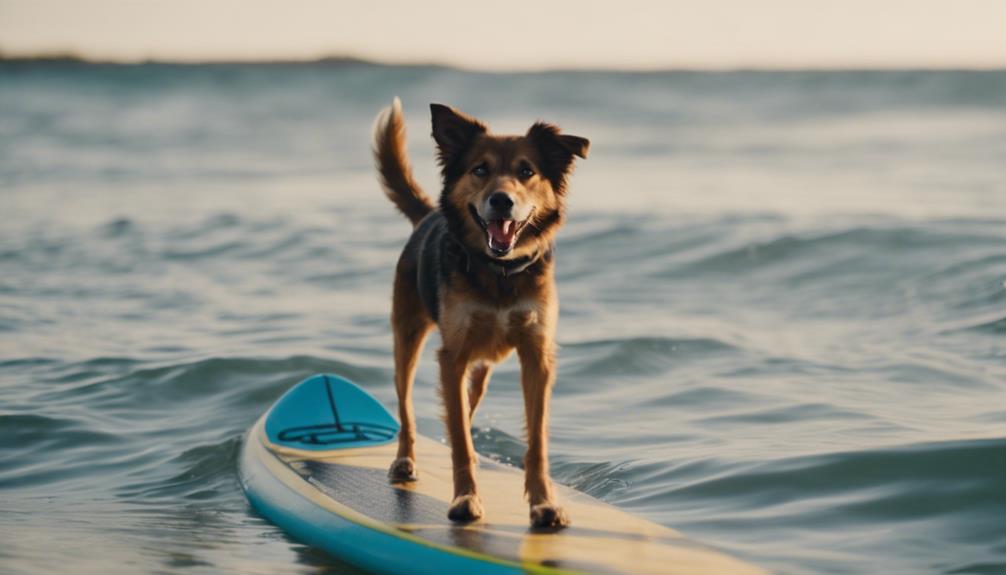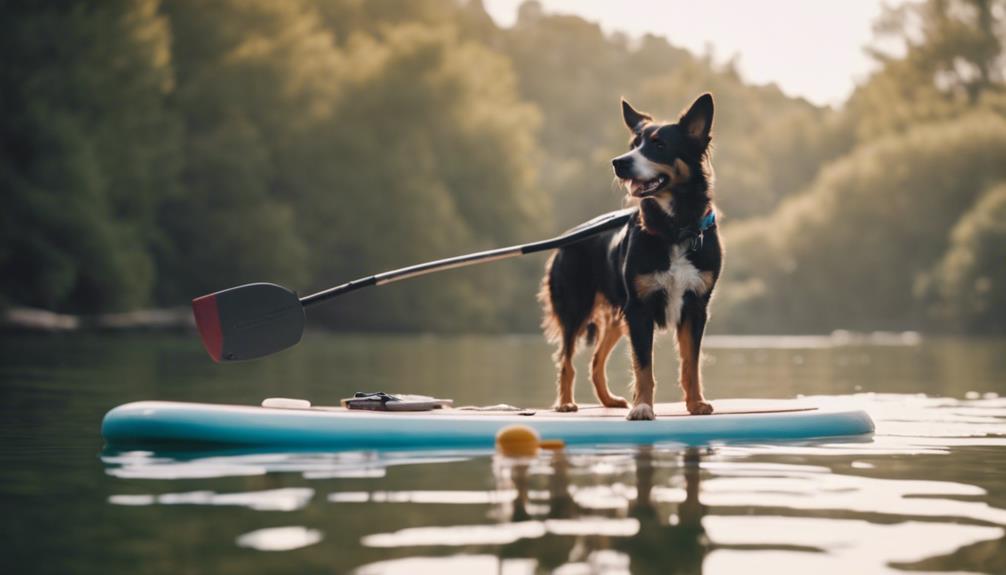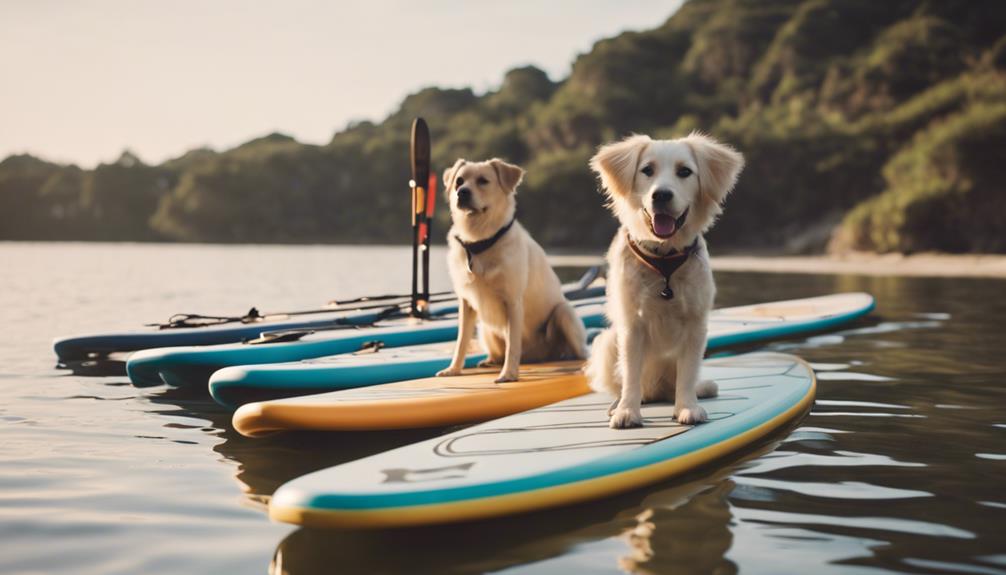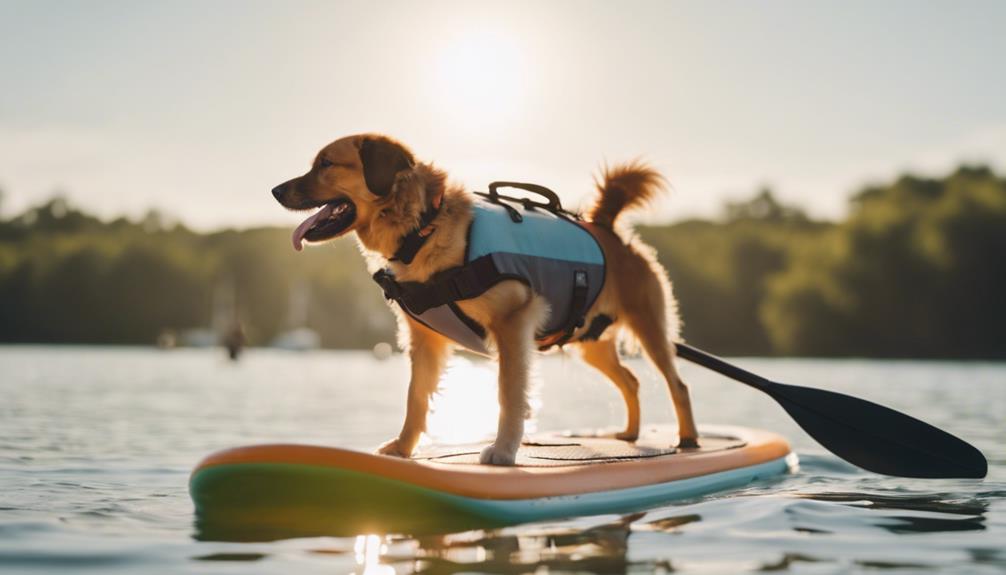Engaging in water activities like surfing or stand-up paddleboarding with your dog can be a rewarding experience, strengthening your bond and creating lasting memories.
The process of teaching your canine companion to navigate the waves alongside you requires careful planning, patience, and the right approach. From initial board familiarization to safety precautions on the water, there are crucial steps to consider.
This article will provide you with expert insights on essential gear, training techniques, and practical tips to ensure a fun and safe experience for both you and your furry friend. Stay tuned for valuable advice on how to make your next aquatic adventure with your dog a success.
Key Takeaways
- Acquire suitable gear for both you and your dog
- Employ positive reinforcement techniques for board introduction
- Build environmental confidence for water activities
- Prioritize safety precautions and monitor comfort and progress
Essential Gear for Surfing or Paddle Boarding With Your Dog
To engage in the thrilling activity of surfing or paddle boarding with your dog, acquiring the essential gear is imperative for a safe and enjoyable experience. Key items include a suitable board that accommodates both you and your furry companion comfortably.
A traction pad on the board provides grip for your dog, while a dog life jacket with a handle ensures safety in case of any unforeseen situations. Remember to bring fresh water and a bowl for hydration, as well as sunscreen specifically designed for dogs to protect their skin from the sun's rays.
Initial Training Steps for Board Familiarization
When embarking on the journey of teaching your dog to surf or paddle board, the initial training steps for board familiarization play a crucial role in establishing a strong foundation for your canine companion's water adventure.
Start by introducing the board to your dog on land, allowing them to sniff and explore it at their own pace. Encourage positive associations by feeding meals on the board and using a wobble board or Bosu to build environmental confidence.
Gradually acclimate your dog to the board near water, first in a pool or at the shoreline before progressing to gentle waves. This step-by-step approach will help your dog feel comfortable and confident on the board, setting the stage for successful surfing or stand-up paddle boarding sessions together.
Positive Reinforcement Techniques for Board Introduction

Implementing effective positive reinforcement techniques is essential for ensuring a successful and rewarding introduction of the board to your dog during the training process.
Start by associating the board with positive experiences; feed your dog meals on or near the board to create a positive connection. Use treats, praise, and toys to reward your dog for showing interest in or approaching the board.
Encourage exploration by gradually increasing exposure to the board in a safe and controlled manner. Utilize clicker training or verbal cues paired with rewards to reinforce desired behaviors around the board.
Consistency and patience are key to building a strong foundation of positivity and confidence in your dog's interactions with the board.
Building Environmental Confidence for Water Activities
Building environmental confidence for water activities involves gradually exposing your dog to various aquatic settings and stimuli, fostering a sense of security and readiness for engaging in surfing or paddle boarding adventures together.
To help your dog build environmental confidence, consider the following steps:
- Introduce your dog to different water environments, such as calm lakes, gentle rivers, and the beach, to acclimate them to various water conditions.
- Allow your dog to observe other dogs or humans engaging in water activities to help normalize the experience and reduce anxiety.
- Use positive reinforcement techniques, such as treats and praise, to associate water environments with positive experiences and create a sense of safety for your dog.
Progression to Water Interaction With the Board

To transition from land-based training to actual water interaction with the board, there are key steps to ensure a smooth progression for your dog's surfing or paddle boarding experience.
As you move into the water phase of training, continue to build your dog's confidence by introducing the board gradually. Start in calm, shallow waters to acclimate your dog to the new environment. Encourage your dog to get on the board while it's floating in the water, using treats and positive reinforcement.
Practice gentle paddling or pushing the board to simulate the movement of waves. Monitor your dog's comfort level and progress at a pace that suits them, ensuring a positive and enjoyable experience as they learn to surf or paddle board alongside you.
Safety Precautions for Surfing or Paddle Boarding
Ensure proper safety measures are in place before embarking on a surfing or paddle boarding adventure with your dog.
Safety Precautions:
- Dog Life Jacket: Obtain a well-fitted life jacket with a handle for easy retrieval in case your dog falls into the water.
- Essential Supplies: Bring fresh water for hydration and pet-safe sunscreen to protect your dog from sunburn.
- Swimming Skills: Confirm that both you and your dog are competent swimmers before venturing into the water together.
Selecting the Right Board for Your Dog

When choosing the appropriate board for your dog to surf or paddle board, consider factors such as board material, size, and stability to ensure a safe and enjoyable experience together.
Opt for a soft-top foam surfboard or one with a traction pad to provide comfort and traction for your dog. Select the board length based on your dog's size to ensure they have enough space to move around comfortably.
Additionally, choose a wide and stable stand-up paddleboard (SUP) with ample traction to prevent tipping over and provide a secure platform for your dog.
Tips for Handling Falls and Recoveries
When your dog falls off the surfboard or paddle board, knowing how to assist them back on board is crucial for ensuring a safe and enjoyable experience. Here are some tips for handling falls and recoveries:
- Stay Calm: Remain composed to reassure your dog and prevent them from getting scared.
- Position the Board: Bring the board close to your dog, making it easier for them to climb back on.
- Use Commands: Train your dog to respond to specific commands like 'up' or 'climb' to aid in getting back on the board efficiently.
Ensuring a Fun and Safe Experience on the Water

To enhance the enjoyment and safety of water activities with your dog, prioritizing preparation and vigilance is essential. Before hitting the water, ensure your dog has a well-fitted life jacket with a handle for easy retrieval in case of emergencies.
Additionally, bring along fresh water and pet-safe sunscreen to keep your furry companion hydrated and protected from the sun's rays. Both you and your dog should be proficient swimmers to handle any unforeseen situations.
Opt for a soft-top foam surfboard or a stable stand-up paddleboard with ample traction to provide a secure surface for your dog. By taking these precautions and being prepared, you can create a fun and safe experience for both you and your canine companion on the water.
Conclusion
In conclusion, by following the recommended gear, training techniques, safety precautions, and board selection tips outlined in this article, you can effectively teach your dog to surf or stand-up paddleboard with you.
With patience, consistency, and a focus on positive reinforcement, you can build a strong bond with your canine companion while enjoying water-based adventures together.
Remember to prioritize safety and ensure a fun and rewarding experience for both you and your furry friend on the water.




